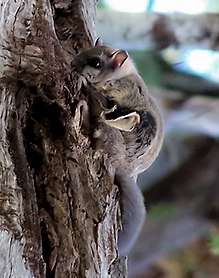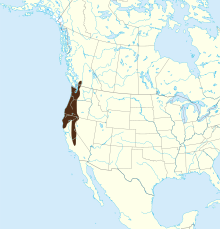| Humboldt's flying squirrel | |
|---|---|

| |
| Conservation status | |
 Secure (NatureServe) | |
| Scientific classification | |
| Domain: | Eukaryota |
| Kingdom: | Animalia |
| Phylum: | Chordata |
| Class: | Mammalia |
| Order: | Rodentia |
| Family: | Sciuridae |
| Genus: | Glaucomys |
| Species: | G. oregonensis |
| Binomial name | |
| Glaucomys oregonensis (Bachman, 1839) | |

| |
Humboldt's flying squirrel (Glaucomys oregonensis) is one of three species of the genus Glaucomys, the only flying squirrels found in North America. The squirrel was named after the naturalist Alexander von Humboldt and California's Humboldt County, which is one of the areas inhabited by the squirrel.
Taxonomy
Using genetic analyses, Arbogast et al. (2017) showed that Humboldt's flying squirrel, previously thought to be conspecific with the northern flying squirrel, was actually a distinct species. The San Bernardino flying squirrel subspecies (G. o. californicus) is considered a Critically Imperiled Subspecies by NatureServe.
Description
They do not actually fly but glide from tree to tree. They are similar in appearance to the northern flying squirrel, however, they are generally smaller and have darker pelage. They are good gliders but clumsy walkers on the ground.
Fluorescence
Under ultraviolet light, females and males of all 3 species of Glaucomys fluoresce in varying intensities of pink on both dorsal and ventral surfaces. The fluorescence is hypothesized to help the flying squirrels find each other in low light and mimic the plumage of owls to evade predation. This hypothesis has been challenged by Toussaint et al. (2022) who instead suggest that the pink luminescence is a byproduct of the body's waste management. Moreover, these authors argue that it is far from evident that UV illuminating sources that occur naturally are sufficient to elicit luminescence distinguishable from ambient visible light. An ecological role for the pink luminescence is therefore not likely.
Diet and behaviour
They feed on a variety of plant material as well as tree sap, fungi, insects, carrion, bird eggs and nestlings. They mostly breed once a year in a cavity lined with lichen or other soft material. Unlike most members of their family, flying squirrels are strictly nocturnal. They nest in the tops of the trees away from the ground and predators.
Distribution and habitat

Humboldt's flying squirrels are found in coniferous and mixed coniferous forests from southern British Columbia to southern California. They live in thick coastal forests where there is plenty of room for them to glide from tree to tree. Populations of Humboldt's flying squirrels are more concentrated in old forests where the relatively stable environment allows for fewer offspring in each litter.
References
- "NatureServe Explorer 2.0". explorer.natureserve.org. Retrieved 30 March 2022.
- ^ Arbogast, Brian S.; Schumacher, Katelyn I.; Kerhoulas, Nicholas J.; Bidlack, Allison L.; Cook, Joseph A.; Kenagy, G. J. (2017). "Genetic data reveal a cryptic species of New World flying squirrel: Glaucomys oregonensis". Journal of Mammalogy. 98 (4): 1027–1041. doi:10.1093/jmammal/gyx055.
- "NatureServe Explorer 2.0". explorer.natureserve.org. Retrieved 30 March 2022.
- "Meet This Newly Discovered Flying Squirrel". 2017-05-30. Archived from the original on May 30, 2017. Retrieved 2018-01-12.
- Anich, Paula Spaeth; Martin, Jonathan G.; Olson, Erik R.; Kohler, Allison M. (2019). "Ultraviolet fluorescence discovered in New World flying squirrels (Glaucomys)". Journal of Mammalogy. 100: 21–30. doi:10.1093/jmammal/gyy177.
- "Flying squirrels are secretly pink". Nature. 566 (7742): 10. 2019-01-28. Bibcode:2019Natur.566R..10.. doi:10.1038/d41586-019-00307-6.
- Toussaint, Severine; Ponstein, Jasper; Thoury, Mathieu; Metivier, Remi; Kalthoff, Daniela; Habermeyer, Benoit; Guilard, Roger; Bock, Steffen; Mortensen, Peter; Sandberg, Sverre; Gueriau, Pierre; Amson, Eli (2022). "Fur glowing under ultraviolet: in situ analysis of porphyrin accumulation in the skin appendages of mammals". Integrative Zoology. 17 (3): 15–26. doi:10.1111/1749-4877.12655. PMID 35500584.
- "New Flying Squirrel Species Discovered along North America's Pacific Coast". Humboldt State University. June 5, 2017. Retrieved 30 June 2017.
- Morell, Virginia (May 30, 2017). "Meet This Newly Discovered Flying Squirrel". National Geographic. Archived from the original on May 30, 2017. Retrieved 30 June 2017.
- Matt Weldy, Clinton W Epps, Damon B Lesmeister, Tom Manning, Eric D Forsman, Spatiotemporal dynamics in vital rates of Humboldt’s flying squirrels and Townsend’s chipmunks in a late-successional forest, Journal of Mammalogy, Volume 101, Issue 1, 21 February 2020, Pages 187–198, https://doi.org/10.1093/jmammal/gyz204.
| Taxon identifiers | |
|---|---|
| Glaucomys oregonensis | |